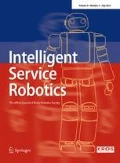Abstract
This paper proposes a robot calligraphy writing method based on style transfer algorithm, which can transfer the art style of Chinese font and maintain the imitation accuracy of the calligraphy. A prototypical similarity evaluation approach is also presented to analyze the calligraphy writing effect, including the similarity ratio of balance, inclination and writing intensity. The robot writing system mainly consists of a six-DOF robot, manipulator, Chinese brush and PC controller. Firstly, input character images are transformed into target style font through training and style transferring process based on generative adversarial networks method. Then, the description parameters of the character images with target style are extracted to control the robot calligraphy writing process precisely. Experimental results show that the minimum similarity between the styles of robot writing characters and target characters is larger than 0.75. The proposed method shows good calligraphy writing effect, which can be used for various calligraphy training processes and trajectory planning applications.












Similar content being viewed by others
References
Yao FH, Shao GF (2006) Modeling of ancient-style Chinese character and its application to CCC robot. In: IEEE international conference on networking, sensing and control, pp 72–77
Yao FH, Shao GF, Yi JQ (2004) Trajectory generation of the writing-brush for a robot arm to inherit block-style Chinese character calligraphy techniques. Adv Robot 18(3):331–356
Bogue R (2017) Recent developments in robotic tactile perception. Ind Robot 44(5):565–570
Lam JHM, Yam Y (2009) Stroke trajectory generation experiment for a robotic Chinese calligrapher using a geometric brush footprint model. In: Proceedings of IEEE/RSJ international conference on intelligent robots and systems, St. Louis, MO, pp 2315–2320
Matsui A, Katsura SA (2013) Method of motion reproduction for calligraphy education. In: 2013 IEEE international conference on proceedings of mechatronics (ICM), IEEE, pp 452–457
Kim SK, Jo J, Oh Y (2014) Robotic handwriting: multi-contact manipulation based on reactional internal contact hypothesis. In: Proceedings of IEEE/RSJ international conference on intelligent robots and systems (IROS 2014), Chicago, IL, pp 877–884
Sun YD, Xu YS (2013) A calligraphy robot—callibot: design, analysis and applications. In: Proceedings of international conference on robotics and biomimetics, pp 185–190
Filiatrault S, Cretu A. M (2014) Human arm motion imitation by a humanoid robot. In: Proceedings of IEEE international symposium on robotic and sensors environments (ROSE), Timisoara, pp 31–36
Man YK, Bian CY, Zhao HB (2010) A kind of calligraphy robot. In: 2010 3rd International Conference on proceedings of information sciences and interaction sciences (ICIS), IEEE, pp 635–638
Droniou A, Ivaldi S, Sigaud O (2014) Learning a repertoire of actions with deep neural networks. In: Proceedings of IEEE international conferences on development and learning and epigenetic robotics (ICDL-Epirob), Genoa, pp 229–234
Chao F, Huang YX, Zhang X, Shang CJ, Yang LZ, Hu HS, Lin CM (2017) A robot calligraphy system: from simple to complex writing by human gestures. Eng Appl Artif Intell 59:1–14
Wang J, Pi YG, Liu MY (2009) Detection of the contour corner of character image based on the freeman chain code. Tech Autom Appl 28(1):88–92
Zhe M, Su J (2017) Aesthetics evaluation for robotic chinese calligraphy. IEEE Trans Cognit Dev Syst 9(1):80–90
Phang SK, Lai S, Fei W, Lan M, Chen BM (2015) Systems design and implementation with jerk-optimized trajectory generation for UAV calligraphy. Mechatronics 30:65–75
Morikawa A, Tsuda N, Nomura Y, Kato N (2017) Self-training system of calligraphy brushwork. In: Companion of the ACM/IEEE international conference on human–robot interaction
Hossain D, Genci Capi, Mitsuru Jindai, Kaneko SI (2017) Pick-place of dynamic objects by robot manipulator based on deep learning and easy user interface teaching systems. Ind Robot 44(1):11–20
Sünderhauf N, Brock O, Scheirer W, Hadsell R, Fox D, Leitner J et al (2018) The limits and potentials of deep learning for robotics. Int J Robot Res 37(4):405–420
Krizhevsky A, Sutskever I, Hinton GE (2012) Imagenet classification with deep convolutional neural networks. In: Proceedings of advances in neural information processing systems, Curran Associates, Red Hook, pp 1097–1105
Goodfellow IJ, Pouget-Abadie J, Mirza M, Xu B, Warde-Farley D, Ozair S et al (2014) Generative adversarial networks. Adv Neural Inf Process Syst 3:2672–2680
Chen X, Xu C, Yang X, Song L, Tao D (2019) Gated-gan: adversarial gated networks for multi-collection style transfer. IEEE Trans Image Process 28(2):546–560
Huang T, Jiang Y (2004) A quick thinning algorithm for handwritten chinese. Comput Eng 30(19):121–128
Chang Y, Lee J, Rijal O, Bakar S (2010) Efficient online handwritten chinese character recognition system using a two-dimensional functional relationship model. Int J Appl Math Comput Sci 20(4):727–738
Rahmani A, Ghanbari A (2016) Application of neural network training in forward kinematics simulation for a novel modular hybrid manipulator with experimental validation. Intel Serv Robot 9(1):1–13
Connolly C (2009) Technology and applications of ABB RobotStudio. Ind Robot 36(6):540–545
Zhang X, Zhao Q, Xue H, Dong J (2011) Interactive creation of Chinese calligraphy with the application in calligraphy education. Transactions on edutainment, vol V. Springer, Berlin
Acknowledgements
This research is supported by the National Natural Science Foundation of China (51805280), the Natural Science Foundation of Zhejiang province (LQ18E050005), the Ningbo Technology Innovation 2025 Project (2018B10005), Zhejiang Province Public Welfare Technology Application Research Project (2017C31094) and the K. C. Wong Magna Fund in Ningbo University.
Author information
Authors and Affiliations
Corresponding author
Additional information
Publisher's Note
Springer Nature remains neutral with regard to jurisdictional claims in published maps and institutional affiliations.
Rights and permissions
About this article
Cite this article
Liang, Dt., Liang, D., Xing, Sm. et al. A robot calligraphy writing method based on style transferring algorithm and similarity evaluation. Intel Serv Robotics 13, 137–146 (2020). https://doi.org/10.1007/s11370-019-00298-3
Received:
Accepted:
Published:
Issue Date:
DOI: https://doi.org/10.1007/s11370-019-00298-3




